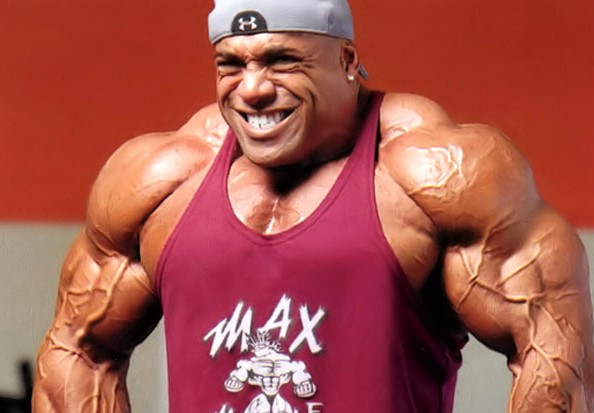Dennis James shrugs. / Chris Lund
Ask a bodybuilder how he built his traps and he’ll simply shrug. Chances are, if you train traps at all, you simply grab a barbell or two dumbbells and move your shoulders up and down for a few sets at the end of your shoulder routine. In fact, there are many variations on the common shrug. We’re going to cover the best of those. But before then, we’ll do a quick trapezius anatomy lesson and then focus on the five most common traps training mistakes. Your trapezius is part of both your shoulders and back, and therefore can be worked with either. Piggybacking with broader workouts or ignored entirely, traps seldom get the honor of their own routine, and yet your trapezius is large, dramatic, and complex, bracketing your delts and neck and forming a kite on your upper back. By contrast, your biceps are puny and simple, and yet you surely have a biceps routine and dote on every curl. Don’t shrug off trapezius training.

TRAPEZIUS ANATOMY
Your trapezius muscle (technically, two muscles: left and right) is more than just slopes atop your shoulders. At the top, it attaches at the base of your skull. It fans out over your shoulders and then drops down and comes together at a point just above your lower back. It is divided by function into the upper trapezius (neck area), middle trapezius (shoulder area), and lower trapezius (mid-back area). On average, the trapezius has virtually the same number of slow-twitch fibers (54%) as fast-twitch fibers (46%), so it is built for both endurance and power.
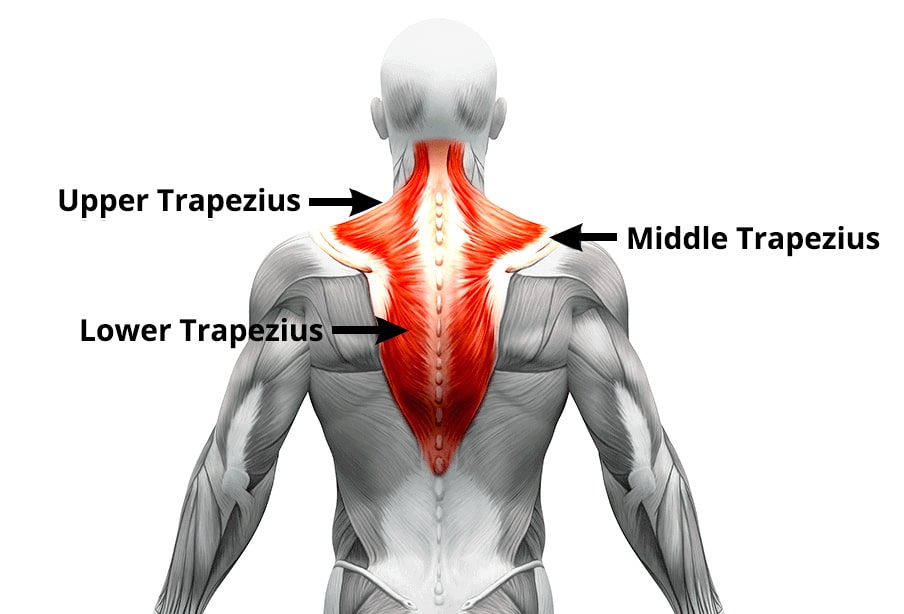
The trapezius stabilizes and moves the scapula (shoulder blades). The upper trapezius raises the scapula (shrugging) and extends the neck. The middle trapezius adducts the scapula (pulls your shoulders back and closer together). The lower trapezius lowers the scapula and assists in adducting the scapula.
TRAPS WORKOUT MISTAKE #1: OVERTRAINING
You may be unaware of how frequently you’re working this muscle. With back, it gets stressed during deadlifts, rows, pulldowns, and many other exercises. With shoulders, it assists in most laterals and presses and does much of the work during upright rows. It even chips in during chest presses, squats, and most biceps curls. And if you’re doing more athletic moves like power cleans or farmer’s walks, your trapezius is pulling overtime duty. Built for endurance, it’s frequently assisting, and this is why it may always be sore and yet never growing.
SOLUTIONS
If you do deadlifts or power cleans as part of your back workout, do shrugs at the end of that workout.
If you do neither deadlifts nor power cleans for back but upright rows are part of your shoulder routine, include shrugs in your shoulder workouts.
Avoid training back and shoulders on consecutive days. Either train them on the same day or schedule at least 48 hours between the workouts.
If trapezius is a strong body part and you do exercises like rack deadlifts or power cleans, you can avoid traps isolation exercises.
TRAPS WORKOUT MISTAKE #2: UNDERTRAINING
While some weight-trainers overtrain trapezius, at least as many undertrain this area. Just because traps are always helping doesn’t mean they’re getting enough targeted work to grow. Too many trainers relegate traps to the afterthought category, tacking a few sets of shrugs onto a workout or, worse yet, never doing any direct trapezius work. But traps is an impressive muscle, especially for men (always visible via a thicker neck), and an important stabilizing and assisting muscle for both men and women.
SOLUTIONS
Think in terms of a traps routine and not just fitting shrugs into your shoulder or back routine.
Do a minimum of two exercises and eight sets in each traps routine.
If your trapezius is especially weak, train it first before an unrelated body part, like hamstrings, and do 10-12 sets.
Include intensifiers in your traps routine, like drop sets (go down the rack of dumbbells when shrugging), supersets (shrugs and upright rows make a good combo), and isometric holds (when you can’t get another full rep of shrugs, hold the weight in a tensed position for as long as possible).
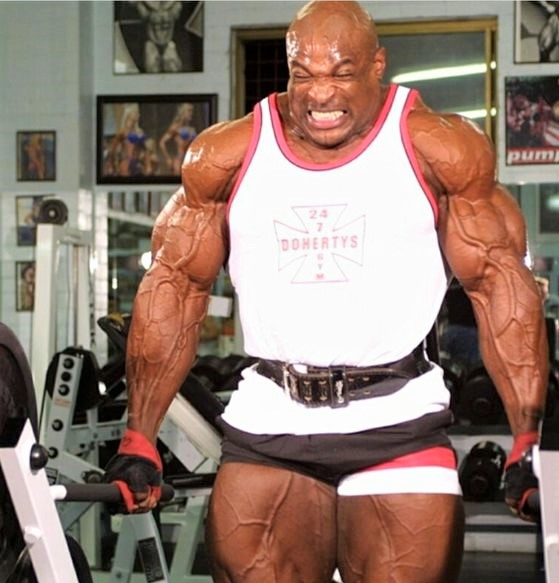
UPPER TRAPS WORKOUT
Dumbbell Shrug — 4 x 8-12 reps
Behind-the-back Smith Machine Shrug — 4 x 10-15 reps
TRAPS WORKOUT MISTAKE #3: FOCUS ON ONLY UPPER TRAPS
Everyone knows about shrugs for isolating the upper trapezius, but too few bodybuilders know how to target their middle and lower traps. These areas will assist on most back exercises, but you may want to include some exercises to specifically target middle and lower traps, especially if upper back thickness is a weakness.
SOLUTIONS
When doing a 45-degree shrug, your arms are at a 45 degree angle to your front torso, thus working both your upper and middle traps. The best way to do this is to lie face down on an incline bench set at 45 degrees. Hold two dumbbells with your arms perpendicular to the floor and shrug up, maximizing the contraction in your scapula at the top.
The Y-raise is a unique way to isolate the lower traps. Lie on a high flat bench and hold two dumbbells with your arms down and perpendicular to the floor. While keeping your elbows locked, raise your arms up and out so your arms and torso form a letter “Y.” Raise your arms as high as possible and hold before returning to the starting position.
Another lower traps isolator is the the reverse shrug. One way to do this is with a pulldown bar and overhead cable (such as at a pushdown station). Start with the bar held down and near your upper thighs. Bring your shoulders up as if shrugging, and then, while keeping your arms straight, push the bar back down. Doing this behind your back has the benefit or letting you also contract your scapula. You can also do reverse shrugs on a dipping machine, pressing the lever arms down while keeping your arms straight.
FULL TRAPS WORKOUT
Barbell Shrug — 4 x 8-12 reps
45-degree Shrug — 4 x 10-15 reps
Y-Raise — 4 x 10-15 reps
TRAPS WORKOUT MISTAKE #4: CONFUSION OF TRAPS AND NECK
Your traps are the surface muscle on the back of your neck, but that’s only one of your neck’s four sides. To fit into shirts with a bigger collar size, you’ll need to do isolation exercises for your neck in addition to your traps routine.
SOLUTIONS
The best way to work your neck is with a four-way neck machine. This allows you to do neck extensions forward, backward, and to the left and right. Do 10-20 reps in each of the four directions for two to four cycles.
If you don’t have access to a neck machine, use either a neck harness and weight or hold a folded towel and a weight plate to your head. Again, work your neck in all four directions.
Just after your traps routine is an ideal time for “heavy necking.”
TRAPS WORKOUT MISTAKE #5: INSUFFICIENT EXERCISE VARIETY
Your upper traps spends most of its time stabilizing and assisting, but when it takes center stage it doesn’t have a lot of tricks to do. Primarily, it moves your clavicles up about three inches. That’s it. So, inevitably, most people train traps with only shrugs, usually with dumbbells and/or a barbell.
SOLUTIONS
We’ve already covered exercises for targeting the middle and lower areas of your triceps: 45-degree shrug, Y-raise, and reverse shrug. There are also compound exercises that work the upper traps, such as the upright row and rack deadlift.
But let’s turn specifically to shrugs for the upper traps. Many gyms have shrug machines, and we recommend you try those. The following 10 shrugging exercises you can do in almost any commercial gym and many you can do at home with minimum equipment. Incorporate one or two of them into every trapezius workout. As with other body parts, try to maximize exercise variety. Just as your biceps workouts shouldn’t consist of only standing two-arm curls, why should you do only standing, two-arm, straight-up-and-down shrugs for your traps? Instead, choose to do, say, one-arm shrugs and behind-the-back shrugs in the same workout or lying shrugs and overhead shrugs. Eventually, try all 10 exercises, and—along with traditional dumbbell, barbell, and machine shrugs—focus on the ones you find most effective.
BEHIND-THE-BACK SHRUG
These are sometimes called “Haney shrugs” because they were a favorite of eight-time Mr. Olympia Lee Haney. Instead of holding a barbell in front of your thighs, hold the barbell behind you. This position forces you to keep your scapula pulled backwards throughout the shrug, thus focusing more on your middle and lower traps. Haney bent his arms a little as he raised the weight to pull it higher, making this something of a behind-the-back upright row. You may find that a Smith machine allows you to better position yourself for this lift.
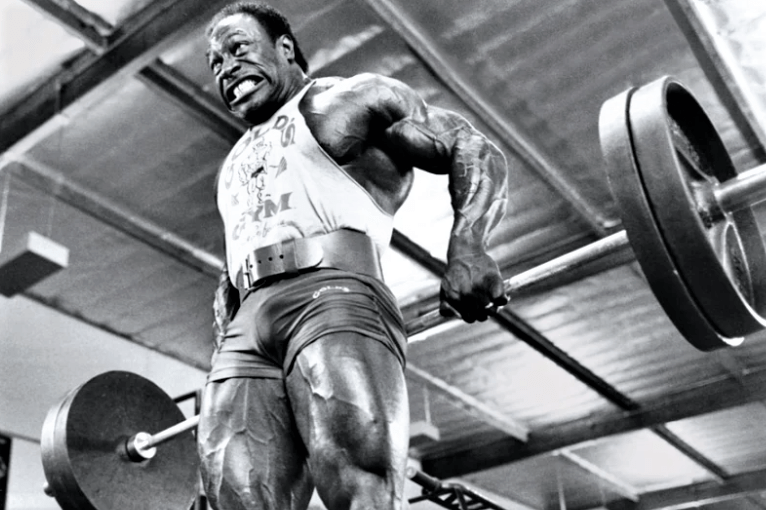
CALF MACHINE SHRUG
Stand in a calf machine with the padded yokes resting on your shoulders. Shrug in the same manner you would if you were holding weights. Because this eliminates the need to hold the resistance with your arms at your sides, your grip will never give out, and there is virtually no pressure on your elbow and shoulder joints. This exercise also locks each rep into the same path of movement.
HOLD SHRUG
You can dramatically boost the intensity of any shrug by holding the top position of each rep for three to five seconds. Such peak contractions are especially effective for shrugs because, with your arms vertical to the floor, gravity is maximizing its pull.
INCLINE SHRUG
Sit face-up on an incline bench, keeping the bench at approximately a 70 degree angle. Hold a dumbbell in each hand with your arms perpendicular to the floor (as if at the starting point of incline dumbbell curls). Then shrug your shoulders. This is a different angle of attack than shrugs done with your torso perpendicular to the floor.
DECLINE SHRUG
This is the inverse of the previous shrug, and similar to the 45-degree bench shrug, just at a lesser angle: about 70 degrees. While lying face-down on an incline bench, hold either a barbell or two dumbbells with your arms straight or slightly bent and shrug straight up or up and back.
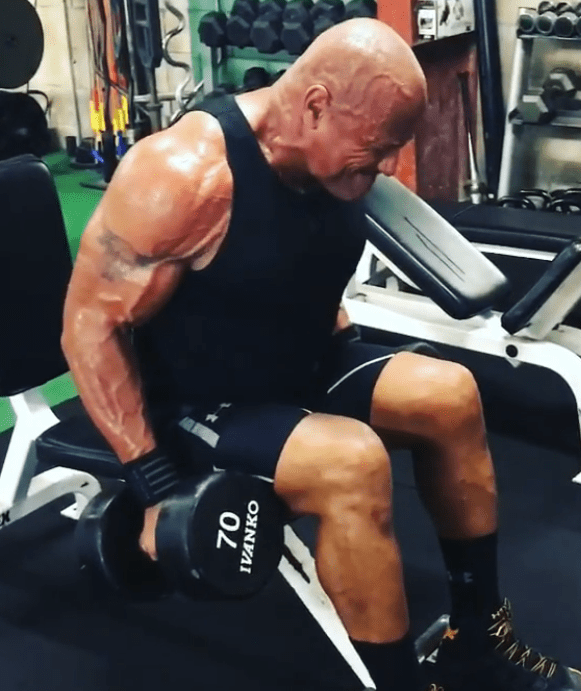
LOW CABLE SHRUG
Grab a straight bar attached to a low cable and stand back so the cable as well as your arms are at approximately a 45 degree angle to the floor. Now shrug your shoulders back and up at the same time. This works all areas of your traps.
ONE-ARM SHRUG
Even if they use dumbbells, most bodybuilders shrug both shoulders simultaneously. However, the trapezius can benefit from unilateral training and a better focus on each individual side just as other muscles can. Holding either a dumbbell or a D-handle attached to a low cable, do all the reps of a set for one side before working the other side. Or, holding two dumbbells or handles, alternate reps for your left and right trapezius.
OVERHEAD SHRUG
Though this unique exercise can be performed with a barbell or dumbbells, we recommend using a Smith machine while seated. The lift begins while holding the bar overhead, as if in the top position of a military press but with your scapula pulled down as far as possible. Then, push the bar up as far as possible by elevating your scapula. Focus only on the up-and-down movement of your shoulders.
SMITH MACHINE SHRUG
Whether you do your shrugs behind-your-back, overhead, or in the traditional arms-down, bar-in-front style, a Smith machine locks the shrugging movement into the same straight vertical path, while simultaneously allowing you to easily alter your body position. For example, you can stand back and bend over slightly at the waist to involve more of your lower traps in the shrugging movement.
TWO CABLE SHRUG
Stand in the middle of a cable crossover station and hold D-handles attached to the right and left cables set in their lowest positions. Shrug while keeping your arms straight and out at approximately 45 degree angles to your body. Because of the position or your arms and direction of the stress, this allows you to more easily contract your scapula (working middle and lower traps) in addition to elevating your scapula (working upper traps).
VARIETY TRAPS WORKOUT
Incline Shrug — 3 x 10-15
Decline Shrug — 3 x 10-15
Two-Cable Shrug — 3 x 10-15
TRAPS WORKOUT: DON’T KEEP IT SIMPLE
Shrugging has a very short range of motion, but that doesn’t mean your trapezius training options are likewise constricted. As this guide explains, there is an abundance of underused exercises. Utilize the exercises and techniques presented here to invigorate your traps workouts. Then, when someone asks how you built your outstanding traps, you can answer with more than a simple shrug.



































